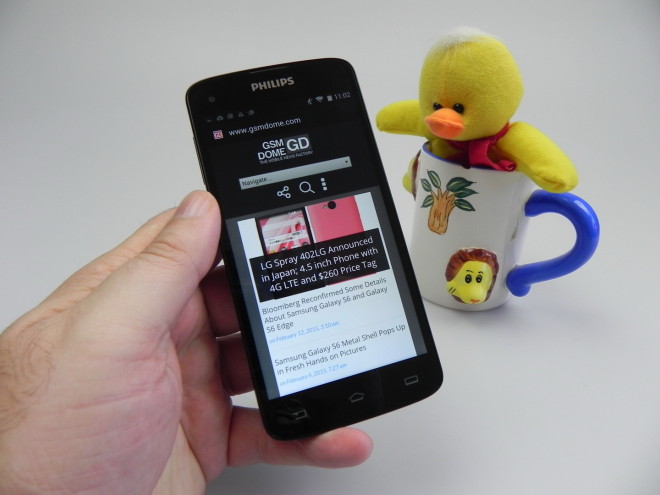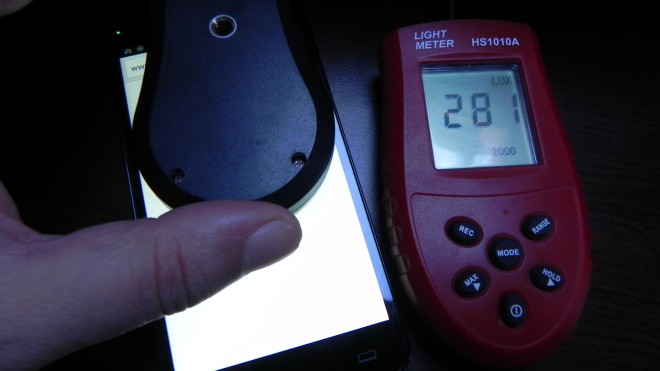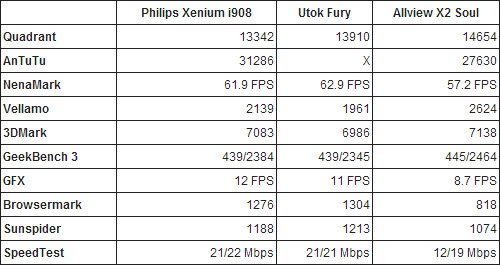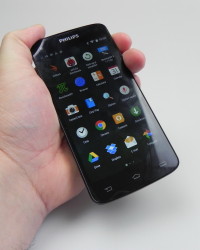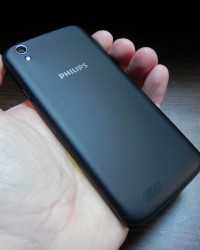The Philips Xenium i908 is a handset we’ve tested quite a few weeks ago and this model debuted in the fall of 2014 in Europe. Usually Philips phones are known through their long lasting batteries, so let’s see if that’s the case here.
The product is priced at $220 in Eastern Europe and it’s an octa core Full HD device with a big battery and affordable price. It measures 8.8 mm in thickness, weighs 156 grams and has a back texture that feels like rubber. Its facade is uniform and the handset adopts a rectangular form factor, with rounded corners. This is quite a long phone for a 5 incher and it’s pretty hard to reach the entire screen with your fingers, so one hand usage isn’t exactly comfy.
The grip is good and the weight is well balanced. The front side is covered with Dragon Trail glass and upfront we find the earpiece, notification LED, front camera and 3 capacitive buttons, plus sensors. At the back there’s the main camera with LED flash, a speaker and once you remove the back cover, you’ll see that it also slightly covers the sides and it’s quite thick.
Below the cover there are two regular SIM slots, a reset button and a microSD card slot. At the top we find an audio jack and microUSB port, plus at the bottom there’s a microphone and on the left we find the volume buttons, that are quite comfy to use. On the right side there’s the On/Off button, with good feedback and overall the design of the Philips Xenium i908 is quite OK, but maybe a bit too elongated.
As far as hardware goes, we get a 5 inch screen on board, with an IPS LCD Full HD panel and a MediaTek MT6592 octa core processor, a Cortex A7 clocked at 1.7 GHz. The GPU here is a Mali 450 MP4 and specs also include 2 GB of RAM, 16 GB of storage, a microSD card slot and a 13 MP main camera. We also get a front 5 MP shooter and on the connectivity side there’s dual SIM dual standby support, HSDPA 21 Mbps download, WiFi b/g/n, WiFi Direct, Bluetooth 4.0, GPS and FM radio. In the section we call “Others” there’s the proximity sensor, light sensor, magnetic sensor and accelerometer.
The battery is a Li-Ion unit with a 3000 mAh capacity and on paper it provides 37 hours of talk time and 45 days of standby time. It’s a non removable unit, by the way. Our test, that involves HD video playback in a loop, with WiFi on and brightness at 50% gave us a time of 7 hours and 26 minutes of functioning, that frankly speaking, could be longer, especially for a Philips.
For example, the Allview P6 Energy scores 12 hours and 9 minutes and the Huawei Honor 6 reaches 8 hours and 58 minutes. This model is still better than midrangers like the Allview V1 Viper S4G, that achieves 5 hours and 19 minutes with similar specs. Charging is a letdown for this Philips unit, taking too long: 4 hours and 25 minutes. The settings area include a special CPU Power Saving mode, as usual for midrangers.
On the acoustics side, we’ve got a stock music player and a reasonably loud experience, also clear and all the notes are heard OK. The bass is also good and there’s no distortion, luckily. The keyboards are well heard, there’s no muffling on flat surfaces and the EQ is the stock one. The headphones look and feel cheap, they have a big remote and sit rigidly in the ear.
They’re also not very loud at max volume and the bass they deliver is so so. There’s FM radio available on the handset, with options like Scan, Speaker or Record. In the Settings area we find the BES Enhanced for both loudness and headphones. We used a decibelmeter to test the speakers of the device and achieved 83.2 dBA at the back and 82.1 dBA upfront, which is close to iPhone 6 Plus levels (83.8 dBA), so not bad at all.
We move on to the display, an IPS LCD Full HD 5 inch unit, with 441 ppi density and a fingerprint magnet to be honest. The screen offers a bright, crisp and vivid experience, although it’s a bit oversaturated. It has wide viewing angles and comes with Clear Motion technology, for improved video fluency. The pixels are of the RGB Stripe kind and the brightness achieved here is 281 LUX units, which is not exactly impressive, since many midrangers are able to reach over 300 or 400 LUX nowadays.
Still, the screen looks like a quality one, especially in games. A quick example of other affordable models with higher brightness: Wiko Rainbow with 424 LUX and the Utok Fury with 465 LUX. The display is overall OK, but it could be brighter. Philips Xenium i908 packs a 13 megapixel main camera, with a Sony Exmor RS sensor, with BSI and autofocus, as well as a 5 megapixel front camera.
The UI features on the left side a front camera shortcut, flash options and Capture Modes (Normal, HDR, Face Beauty, Panorama, Multi Angle, Auto Detect Scene, Auto Smile Capture, Consecutive Shots, Gesture Shot and Live Photo). We’ve also got white balance settings and the options, that include GPS, Exposure, Color Effects, Scene Mode, Clarity, Hue, Saturation, Brightness, Contrast and Anti Shake. There’s also Zero Shutter Delay, Voice Command, Face Detect, Timer and Continuous shot.
You can set up the resolution at 13 MP, 12 MP or 8 MP and ISO up to 1600. The video options include electronic image stabilization, audio mode, time lapse and resolution (Full HD or HD). On the right side we find the gallery shortcut and effects. The camera offers a reasonably fast focus, 4X zoom, not very fast picture taking and a strong flash.
We took the photos shown in this gallery on a cloudy day and I have to say that the HDR tends to apply a white hue to the image. The panorama is nice and wide and we’ve got good and fast stitching. The colors of the shots are a bit too saturated, but the details are OK. Focus and white balance are good and the horse macro was quite nice, as well as the one of the red chair.
The pictures that have grey, white or black in them come off with a strange exposure, though. The level of detail in zoomed in shots is quite good and the shadows caught on camera are weak. Colourful shots suit this phone better than white, black or gray ones. On the video side we’ve taken Full HD 30 FPS clips with 17 Mbps bitrate and 3GPP format.
The acoustics are OK, colors are quite good and focus is also decent. The stabilization was a bit above what we expected and the level of detail is nice. Early on in the videos the image feels a bit burnt and the exposure change is a bit violent when switching from a well lit area to shade. Overall, the camera of the Philips Xenium i908 offers good quality for a $200+ price.
Sometimes this camera felt better than my own iPhone 5, so that’s a compliment for the phone reviewed here. On the photo editing side of things, there are frames available, filters, crop, rotate, mirror options, plus contrast and shadows. Then we go to the performance analysis, where this model achieved 44 degrees Celsius, after playing 15 minutes of the game Riptide GP2, which means it overheats.
The browser on the smartphone isn’t very fast, but the stock keyboard is quite comfy. The telephony section brings 3G only on one SIM card at a time, dual standby support and a powerful signal on both cards. The calls are loud and clear and we’ve also got speed dial. Now we get to the benchmarks, where we compared the Philips I908 with the Utok Fury and Allview X2 Soul.
All 3 models have 2 GB of RAM, 16 GB of storage and 5 inch screens. Here are the results:
The Philips unit wins 3 out of 10 battles, which is unimpressive, but we don’t have a big lag here. We do have an UI that’s not as fluid as we’d ideally like it to be. We still can run the game Riptide GP2 without problems and with some graphics effects enabled. The OS here is Android 4.4.2, in a stock version with minor customization, usually related to some icons.
If you keep the screen pressed, you will see mostly stock widgets and the multitasking is done via swiping. The dropdown area includes notifications and quick settings, among the latter also being Glove Mode. The Settings area is standard and luckily the list of apps doesn’t include bloatware. There’s the usual Calendar, Chrome, Drive, File Manager, Gmail, Google+, Hangouts, Maps and Movie Studio.
There’s also News and Weather, Notebook, Photos, the Play Suite, Sound Rec, To Do, YouTube and Kingsoft Office. Now let’s see the Pros and Cons related to this model.
Here are the Pros:
good grip
solid build
OK battery
OK acoustics
good photo and video capture
no bloatware
big SIM slots for users with older SIMs
And the Cons:
huge charging time
overheats
fingerprint magnet
could be brighter
Philips Xenium i908 gets from us an 8.7 for design, a 9.2 for hardware and a 9.2 for OS and UI. The final grade is 9.03 out of 10 and overall this unit stands out through camera capture and speakers, as well as a reasonable battery and lack of bloatware.


